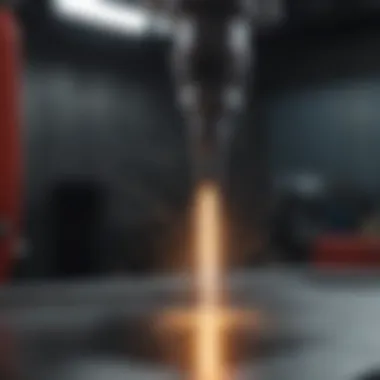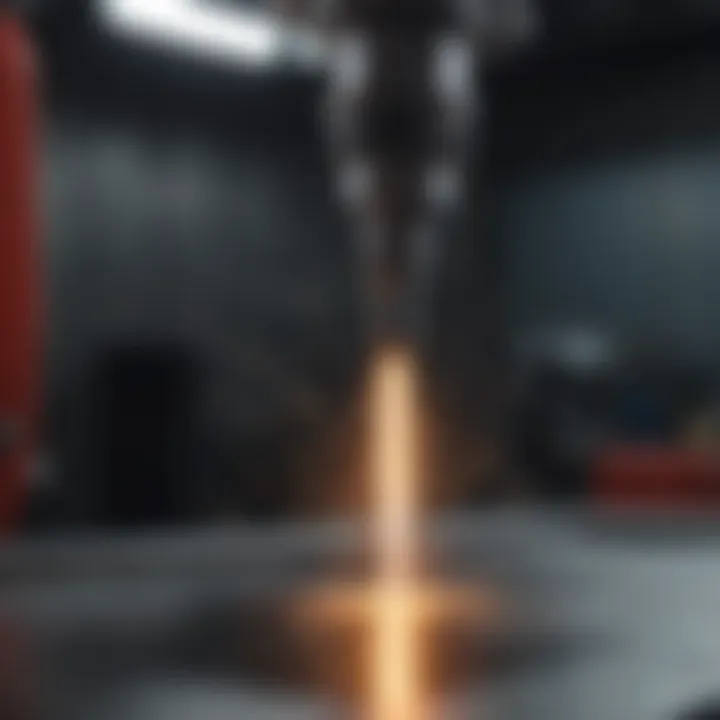Exploring Plastic Assembly: Techniques and Trends


Intro
Plastic assembly is an integral aspect of modern manufacturing, pivotal in creating diverse products that populate our daily lives. It encompasses a variety of techniques for joining plastic components, tailored to suit different applications across industries like automotive, aerospace, and consumer goods. In this article, we delve into the nuances of plastic assembly, shedding light on its techniques, the breadth of its applications, and the emerging trends shaping its future.
Understanding the fundamental concepts and vocabulary in plastic assembly enables a clearer grasp of its complexities. As we explore various methods from welding to adhesive bonding, it becomes evident that each technique has its own sets of advantages and challenges, inviting continued research and innovation.
In the following sections, we will discuss definitions, key terminology, our main findings, and potential future directions in the realm of plastic assembly, creating a well-rounded narrative for students, researchers, educators, and professionals keen on understanding this critical subject.
Prelims to Plastic Assembly
Plastic assembly is a fundamental element in the manufacturing world, serving as the backbone for countless products we encounter daily. The significance of understanding plastic assembly lies in its multifaceted applications and the vast array of techniques employed to join plastic components securely and efficiently. This article will demystify the science and art behind various plastic assembly methodologies, delving into their relevance across different industries, benefits, and future trends.
Definition and Importance
At its core, plastic assembly refers to the methods used to join plastic components to create a cohesive unit. The importance of this topic is pronounced, considering the rise of plastic in modern manufacturing. Plastics are lightweight, versatile, and cost-effective, making them ideal materials for many sectors, including automotive, medical, and consumer goods. Drawing connections to the definition of plastic assembly, one can see that it facilitates not just the production of end products but also influences the quality, safety, and longevity of these items. Techniques like welding, bonding, and fastening are not mere technicalities; they are crucial in ensuring performance and durability. Therefore, mastering the nuances of plastic assembly can lead to better product designs, enhanced functionality, and reduced manufacturing costs, elevating a company’s competitive edge in the market.
Historical Perspective
The evolution of plastic assembly is a fascinating tale of innovation driven by necessity. In the early 20th century, plastics began to gain traction as substitutes for traditional materials like wood and metal. The introduction of early thermoplastics, such as Bakelite in 1907, marked the dawn of a new era. Initially, techniques were rudimentary and often involved simple mechanical fastening or adhesive methods.
As industries expanded, the limitations of early methodologies became apparent. By the 1950s and 60s, advances in polymer chemistry and materials science paved the way for groundbreaking plastic assembly techniques. Ultrasonic and laser welding emerged, revolutionizing the ability to bond plastics with precision and speed. The historical perspective depicts a landscape where ongoing research and technological advancements continuously shape the practices we rely on today. In fact, understanding this timeline not only gives us insights into current practices but also lets us forecast future trends in a rapidly changing manufacturing environment.
"The journey of plastic assembly is one of adaptation and innovation, where each advancement builds on the mistakes and breakthroughs of the past."
In summary, the study of plastic assembly isn't just relevant; it's critical for anyone engaged in product design or manufacturing processes. The intersection of history, technique, and application forms a narrative rich with potential, waiting to be explored.
Types of Plastics Used in Assembly
Understanding the various types of plastics available is essential when discussing plastic assembly. These materials can greatly influence the choice of assembly technique and the overall performance of the final product. Different plastics exhibit unique properties that cater to diverse applications, making a foundation of knowledge about them crucial.
Thermoplastics vs. Thermosetting Plastics
When diving into the world of plastics, one must differentiate between thermoplastics and thermosetting plastics.
- Thermoplastics soften when heated and can be reshaped multiple times without significant degradation. This property allows for flexibility and ease of processing, making them ideal for a variety of assembly techniques. For instance, Polyethylene and Polypropylene, two common thermoplastics, are used in heaps of applications from packaging to automotive parts. They essentially provide the ability to modify and recycle products, leading to less waste and increased sustainability.
- Thermosetting plastics, on the other hand, undergo a hardening process once formed. After curing, they cannot be remolded. This characteristic is beneficial for applications that demand high strength and durability. For example, Epoxy resins are frequently used in the manufacturing of high-strength components, such as those found in aerospace applications. The trade-off here is the lesser flexibility compared to thermoplastics.
Both types have their place in the industry, with their unique benefits contributing to the field of plastic assembly.
Commonly Used Plastics
Diving deeper into commonly used plastics reveals the distinct advantages and characteristics they offer in assembly processes.
Polyethylene
Polyethylene is one of the most widely used plastics in assembly due to its remarkable versatility. Its low density and good chemical resistance make it a popular choice for packaging and consumer products. The unique feature of polyethylene is its adaptability, allowing it to be molded into countless shapes and forms. In assembly, its resilience against impact makes it a favorable option for products that require durability without excessive weight. However, it can be challenging to bond with certain adhesives, which may require surface treatment for effective joining.
Polypropylene
Polypropylene stands out due to its excellent fatigue resistance and lightweight nature. This plastic is a game changer in creating products that need to endure repetitive stress without bending or breaking. Its chemical resistance adds to its appeal, particularly in automotive and medical applications. One aspect to note is that its low surface energy can make adhesion a bit tricky; specialized adhesives may be needed. Overall, the advantageous features of polypropylene solidify its status in the assembly landscape.
Polyvinyl Chloride
Polyvinyl Chloride, often just called PVC, is notable for its rigidity and high resistance to corrosion. It has found its niche in plumbing, construction, and medical devices due to these attributes. PVC is easy to assemble, offering a plethora of bonding options due to its surface properties. However, one must consider the environmental impact, as the manufacturing and disposal of PVC can raise concerns, making sustainability efforts crucial when using this plastic.
Polycarbonate
Polycarbonate is recognized for its incredible impact resistance and clarity. Used in applications ranging from eyewear lenses to safety shields, this plastic offers excellent durability. Its ability to withstand high temperatures is another bonus, making it suitable for applications demanding thermal stability. Although polycarbonate tends to be on the pricier side, its unique features justify the investment in many scenarios. However, it can be susceptible to scratches if not treated properly, which requires consideration during assembly processes.


"Choosing the right type of plastic for assembly is not merely a technical decision, but one that affects sustainability, performance, and cost-effectiveness in significant ways."
Key Assembly Techniques
Key assembly techniques represent the backbone of the plastic assembly process. Understanding these methods is crucial, not just for good practice, but also for enhancing performance, durability, and efficiency in the final products. Each technique has its unique applicability depending on material properties, end-use requirements, and operational costs. Whether it’s for automotive parts, medical devices, or consumer electronics, the right choice of assembly method influences the effectiveness and longevity of plastic products.
Welding Techniques
Ultrasonic Welding
Ultrasonic welding is a notable method in the world of plastic assembly. It uses high-frequency sound waves to create a strong bond between thermoplastics. The beauty of ultrasonic welding lies in its ability to join materials quickly and without the need for additional adhesives or fasteners. One key characteristic of this method is that it minimizes thermal exposure, which helps in preserving the integrity of the materials being joined.
What makes ultrasonic welding a popular choice in this article is its efficiency in terms of time and energy consumption. The process completes usually in just seconds, reducing production time significantly. However, it does have its limitations. For example, this method is often less effective on thicker materials and can require careful calibration to ensure optimal results.
Hot Plate Welding
Hot plate welding involves heating the plastic parts to be joined and then pressing them together. This method is particularly effective for larger components where other welding techniques might struggle. A key characteristic of hot plate welding is that it allows for better control over the joining temperature and speed, leading to stronger bonds.
In the context of this article, hot plate welding stands out due to its adaptability for various plastic types and thicknesses. However, the method has its drawbacks too. The surface of the components needs to be clean and free of contaminants for a successful bond, which can add extra steps in the preparation process.
Laser Welding
Laser welding is another advanced technique worthy of attention. Utilizing focused laser beams, this method generates a localized heat to fuse plastic parts together. Its precision makes it ideal for assemblies that require tight tolerances, such as in high-tech applications.
A major selling point for laser welding discussed in this article is its ability to handle complex geometries seamlessly. This technology reduces the risk of warping or degradation associated with other welding methods. Nevertheless, it bears higher initial investment costs and requires skilled operation, which can deter some manufacturers from adopting it.
Adhesive Bonding
Adhesive bonding encompasses a wide range of options for joining plastic materials. The right adhesive can often lead to superior bonding strength, flexibility, and resistance to environmental factors. A prominent characteristic of different adhesive types is their versatility; they can bond different substrates which is crucial in multi-material assemblies.
In the scope of this topic, adhesive bonding is especially valuable, providing solutions where welding might not be feasible. However, selecting the wrong adhesive or improperly applying the adhesive can lead to failures, highlighting the need for comprehensive knowledge in this area.
Types of Adhesives
The types of adhesives available are numerous, ranging from solvent-based to water-based formulations. They each come with their own characteristics. Solvent-based adhesives typically cure through evaporation, creating a strong bond but often releasing VOCs (Volatile Organic Compounds), which can be a health concern. In contrast, water-based adhesives are more environmentally friendly but may not offer the same bonding strength under certain conditions.
The versatility of adhesive choices makes this a compelling subject in the article, allowing manufacturers to tailor their assembly processes to meet specific demands according to industry standards.
Surface Preparation Techniques
Surface preparation techniques are essential in adhesive bonding; they decide whether the adhesive will successfully adhere to the surfaces or not. Techniques may include cleaning, sanding, or applying a primer before adhesive application. A significant aspect of these techniques is the enhancement of the bonding surface, ensuring that contaminants do not compromise the bond.
In this article, it is emphasized that preparation directly influences adhesive performance. Neglecting this step can lead to unforeseen assembly failures, perhaps the biggest risk in any assembly operation.
Mechanical Fastening Methods
Mechanical fastening methods like screws and bolts offer reliable alternatives for joining plastic assemblies. With high strength and simple application, they are widely used across industries. Highlighting the capacity for disassembly in cases of maintenance or repair, mechanical fasteners offer a unique advantage over other techniques.
Screws and Bolts
Screws and bolts are among the most common and effective fastening methods available. Their key characteristic is the ability to provide a strong, durable connection that can tolerate mechanical stresses. The versatility of screws and bolts allows them to be employed in a variety of settings, from automotive to household applications.
One advantage, as discussed in this article, is their ease of use. Even non-professionals can manage basic fastening with minimal tools; however, one downside can be the potential for stripping screws, especially in softer plastics.
Riveting
Riveting, while sometimes overlooked for plastics, offers secure fastening ideal for permanent joins. The process involves deforming the end of a pin to create a strong bond, making it particularly beneficial when dealing with thick materials. In this article, riveting’s capacity for providing structural integrity in assemblies is emphasized.
Riveting carries its own set of advantages and disadvantages. On one hand, it’s great for permanent connections; on the other, once riveted, disassembly isn’t possible without destroying the rivet. Yet, in applications where durability and permanence are paramount, riveting remains a solid choice.


Factors Influencing Plastic Assembly
In the realm of plastic assembly, a myriad of factors plays a pivotal role in determining both the success of the assembly processes and the quality of the final product. These elements can either enhance or hinder the effectiveness of various techniques, directly impacting performance, durability, and ultimately, usability. Likewise, observing these influences is vital, as it assures the streamlining of production and the optimization of resources, which are critical in today's highly competitive market.
In this article, we shall explore two fundamental aspects that significantly dictate the trajectory of plastic assembly: material compatibility and environmental considerations. Understanding these factors not only sheds light on the mechanics behind assembly but also provides insight into best practices that can be adopted across different industries.
Material Compatibility
The term "material compatibility" refers to how well different types of plastics interact when joined together. It's not merely a technical concern; it’s the cornerstone of durable and reliable plastic components. If materials do not mesh well during assembly, the integrity of the final product can suffer, leading to premature failure or breakdown. This can occur if dissimilar plastics are welded or bonded without considering their thermal properties, chemical resistances, and mechanical behaviors.
For instance, polypropylene and polyvinyl chloride might seem compatible at a glance, but their contrasting thermal expansion rates can lead to disastrous results if they are joined without regard to this critical factor. Various testing methods, such as compatibility tests and joint design evaluations, should be performed to predict how materials will behave together under different thermal and mechanical conditions.
Proper assessment of material compatibility reduces waste and boosts efficiency, ultimately saving on costs while enhancing product safety and quality.
Taking into account compatibility aids in the selection of suitable assembly methods. For instance, if two thermoplastics are found to be compatible, ultrasonic welding or adhesive bonding might be employed. Conversely, if they are not, alternative methods or materials may be warranted to prevent compromising the assembly's quality.
Environmental Considerations
As industries progress towards sustainability, environmental considerations in plastic assembly have moved to the forefront. The ecological footprint of producing plastic goods cannot be ignored, making it essential to consider not only the materials used but also the methods of assembly.
Reduction of waste is key. One significant way to achieve this is through the implementation of environmentally friendly adhesives and the adoption of energy-efficient assembly techniques. Reducing the carbon footprint during the assembly process also encompasses waste management – recycling scraps from the assembly lines, ensuring they are transformed back into usable materials rather than being discarded.
The assembly environment must also be factored into the equation. Humidity, temperature fluctuations, and contaminants can affect adhesive properties and the overall assembly process, leading to subpar results. This is an even more pressing issue in regions with extreme weather conditions or industrial pollution.
Furthermore, many manufacturers are increasingly looking at lifecycle assessments as a framework, evaluating how plastics can remain in a closed loop, ultimately enabling a circular economy where materials are reused and repurposed.
In summary, the interplay of material compatibility and environmental considerations creates a landscape in which plastic assembly can thrive. By prioritizing these elements, industries can foster innovations that not only meet modern demands but also contribute positively to the planet's future.
Adopting these strategies not only promotes success in individual assembly projects, but also aligns with the growing expectation for sustainable practices in manufacturing.
Applications Across Industries
The diverse applications of plastic assembly techniques span a multitude of industries, underscoring their criticality and versatility in today's manufacturing landscape. Understanding these applications not only highlights the benefits of plastic assembly but also unveils considerations that must be addressed. From enhancing product durability to reducing production costs, the implications are profound.
In various sectors such as automotive, consumer electronics, and medical devices, plastic assembly plays a vital part in ensuring that components work seamlessly together. Each industry harnesses unique methods tailored to fit its specific requirements, which can vary significantly in terms of regulatory standards, material properties, and performance expectations.
"In modern manufacturing, a solid grasp of how and where plastic assembly techniques are applied can make all the difference in product reliability and consumer trust."
Automotive Industry
The automotive industry is a prime example of plastic assembly's impact. Here, the use of plastics has surged over the years, driven by a need for lighter and more fuel-efficient vehicles. Assembly techniques like ultrasonic welding and adhesive bonding are often employed to join plastic components that meet stringent safety standards without adding excessive weight.
Furthermore, plastics are utilized in various automotive components ranging from dashboard assemblies to headlights. Using these materials can reduce manufacturing costs and improve fuel efficiency due to their lightweight nature. The traditional methods, such as metal stamping, are often replaced or complemented by plastic assembly processes, as these can offer precision and flexibility in design, accommodating complex shapes and features.
Consumer Electronics
In the realm of consumer electronics, plastic assembly techniques are indispensable. Consider the crafting of smartphones, tablets, and wearable devices. The use of advanced adhesive bonding eliminates visible fasteners, providing a sleek aesthetic that aligns with consumer preferences for minimalist design. Moreover, these methods maintain structural integrity and ensure that components are tightly sealed, enhancing durability against environmental factors.
As devices evolve rapidly, manufacturers prioritize speed and efficiency in production. Techniques like laser welding ensure that assembly times are minimized without sacrificing quality. This necessity for quick turnaround times drives innovation in assembly techniques, as brands compete to deliver the next cutting-edge gadget to market.
Medical Devices
Medical devices represent another crucial area where plastic assembly plays a significant role. Given the strict regulations governing the production of medical instruments, plastic materials are often selected for their biocompatibility and ease of sterilization. When assembling devices such as syringes, IV bags, and diagnostic tools, methods like hot plate welding are favored, offering robust bonds that ensure safety and reliability.
Additionally, advancements in assembly technologies contribute to the evolution of medical devices. As patient care continues to emphasize minimally invasive procedures, the demand for more sophisticated and intricate devices increases. This demand propels the development of specialized plastics and innovative assembly methods, thus transforming the landscape of healthcare technology.
Challenges in Plastic Assembly
Plastic assembly is a critical component of various industries, yet it comes with its share of challenges. Understanding these difficulties is important for anyone involved in the design and production processes. Addressing issues such as mechanical properties and quality control can significantly enhance the reliability and effectiveness of assembled products. This section delves into these challenges, providing a holistic view of the obstacles at work in plastic assembly.


Mechanical Properties
The mechanical properties of plastics can greatly influence how components behave when assembled. Factors like tensile strength, impact resistance, and flexibility play pivotal roles in determining the overall durability of the end product. For instance, using polyethylene in an automotive assembly might work well for certain parts but could falter if high strength is a requirement. In critical applications, understanding the precise mechanical behavior of the plastics involved becomes paramount. If the materials can’t withstand operational stresses, it could lead to catastrophic failures.
Key Points of Concern:
- Tensile Strength: The ability to withstand pulling forces. Not all plastics share the same metrics.
- Impact Resistance: Critical for applications like protective gear, where sudden force is expected.
- Flexural Modulus: Determines how much a plastic can bend without losing its shape.
"Choosing the right material requires testing and understanding how plastics react under different conditions."
Quality Control Measures
Ensuring that every assembled piece meets industry standards is a daunting task. Quality control measures must adapt to the unique challenges presented by plastic materials. Variations in temperature during assembly, improper bonding methods, or the presence of defects can compromise the integrity of products.
A robust quality control system can help mitigate risks. This includes:
- Regular Testing: Rigorous testing protocols examine properties such as adhesion strength and dimensional accuracy.
- Visual Inspections: Early detection of issues like bubbles or inconsistencies can save costs later.
- End-of-Line Testing: Final products can undergo checks for functionality and durability in real-world scenarios.
Employing these methods aids in making sure that every component functions as intended, preventing costly recalls or failures down the line.
Understanding these challenges helps companies not only improve their processes but also ensures long-lasting and reliable products. As industries continue to evolve and adapt, recognizing and overcoming hurdles in plastic assembly remains a priority.
Innovations and Future Trends
The realm of plastic assembly is undergoing significant transformations driven by advancements in technology and an increasing emphasis on sustainability. As we embark on this journey into the future of plastic assembly, it is essential to recognize how innovations not only enhance manufacturing processes but also address the pressing challenges posed by modern industry. These innovations will redefine the way plastic components are assembled, leading to improved efficiency, reduced waste, and enhanced performance.
Advancements in Assembly Techniques
The prevailing innovation landscape within plastic assembly is marked by a variety of new techniques that are both efficient and versatile. Take, for instance, the emergence of advanced robotic systems. These systems are equipped with precision tools that allow for intricate assembly tasks that were previously challenging or impossible. One area of impact is the automotive sector, where robots can perform high-speed assembly with exceptional accuracy, minimizing human error.
Another noteworthy advancement is in the domain of laser welding. This technique has gained traction due to its ability to create strong bonds without the need for additional materials. The ability to control the heat source precisely means that even delicate components can be joined without damage. It's like using a scalpel instead of a butcher's knife—precision is key.
Moreover, the adoption of smart sensors in assembly lines is revolutionizing quality control. By continuously monitoring various parameters during the assembly process, these sensors can detect deviations in real-time. Such innovations not only reduce scrap rates but also ensure quality standards are consistently met, akin to having a vigilant overseer spotting mistakes before they escalate.
Sustainability and Recycling Practices
With growing awareness of environmental issues, sustainability has become a pivotal focus in plastic assembly. Efforts are being made to develop biodegradable adhesives and recyclable materials that do not compromise on performance. The idea is to create a closed-loop system where plastic products can be reused and repurposed instead of ending up in landfills.
In addition, companies are embracing recyclable assembly techniques. For instance, assemblies previously bonded with permanent adhesives are now increasingly using mechanical fastening methods whenever possible. This not only simplifies disassembly but also allows for easier recycling of components at the end of their life cycle.
"The shift towards sustainability in plastic assembly is not merely a trend, but a necessity for the future of our planet."
There’s also a growing implementation of life cycle assessments to evaluate the environmental impact of various assembly techniques. This kind of rigorous analysis helps manufacturers make informed decisions about materials and methods. By taking a thorough approach to evaluating the complete lifecycle of plastic products, businesses are positioning themselves as responsible players in a market that increasingly values sustainability.
As we navigate these trends, it's clear that the innovations in plastic assembly are not just about technical upgrades; they are about embracing a broader responsibility towards the environment. This evolution reflects a collective desire to harmonize industrial practices with ecological awareness, ensuring that future generations benefit from the same resources we do today.
Culmination
In wrapping up our discussion on plastic assembly, it becomes evident that this topic plays a fundamental role in modern manufacturing processes across various industries. Understanding the principles, techniques, and challenges associated with plastic assembly is critical for researchers, educators, and professionals alike. Plastic assembly is not just about joining materials; it serves as a bridge between innovation and practical application. This section will further explore the essential elements that highlight the significance of this subject.
Summary of Key Points
To give a clearer picture, here’s a recap of the vital points addressed throughout the article:
- Diverse Techniques: We have looked into various methods, such as welding, adhesive bonding, and mechanical fastening. Each technique has its unique properties and is selected based on specific project needs.
- Material Selection: Knowledge about thermoplastics and thermosetting plastics helps in understanding which materials are suited for particular applications, influencing durability and performance of assembled products.
- Application Spectrum: The far-reaching applications of plastic assembly, especially in the automotive sector, consumer electronics, and medical devices, underline its importance across industries. Each application comes with its own set of requirements and challenges.
- Challenges: Mechanical properties and quality control are critical topics that demand continuous attention. By addressing these challenges, we can enhance the reliability of plastic assembly methods.
- Future Trends: Innovations are on the horizon, particularly in sustainable practices and advanced assembly techniques which promise to reshape this field significantly.
The Future of Plastic Assembly
Looking ahead, the future of plastic assembly appears promising yet complex. As industries increasingly prioritize sustainability, recycling practices are becoming central to plastic assembly. The integration of new materials, such as bio-based plastics, is already generating interest and may soon transform standard practices.
Innovation in assembly techniques will likely continue to evolve, driven by advancements in technology. For instance, automated systems using artificial intelligence could make processes faster and more efficient. Moreover, as the demand grows for lightweight yet durable materials, the methods of assembly, like laser welding or 3D printing techniques, will likely dominate the landscape.
"If history teaches us anything, it is that adaptability will define the next era of plastic assembly. Companies that embrace change will thrive, while those resistant may fade into irrelevance."
In summary, the domain of plastic assembly is on the cusp of a transformation powered by technology, material science, and environmental consciousness. By staying abreast of these developments, industry participants can better prepare for the challenges and opportunities that lie ahead.







